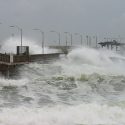Researchers track clarity of Wisconsin lakes from space
Assisted by hundreds of volunteers around the state, UW researchers and their partners have developed a method of assessing the water quality of Wisconsin’s lakes from space.
Using images captured 438 miles above the earth, they have completed the first satellite-based inventory of the clarity of the largest 8,000 lakes in the state. The inventory is available to the public in map form on the Web, where it is possible to zoom in for a close look at your favorite lake or group of lakes.
“We are pleased to help usher in the Year of Water in Wisconsin with a new tool to aid in monitoring lake water quality statewide,” says Thomas Lillesand, who led the effort as director of UW–Madison’s Environmental Remote Sensing Center, part of the Gaylord Nelson Institute for Environmental Studies.
“Our research aims to integrate satellite data into the state’s day-to-day lake management programs. This won’t eliminate the need for conventional water quality monitoring, but it will greatly increase the benefits of ground-based sampling.”
The statewide effort is part of a multifaceted research project funded by NASA called the Satellite Lake Observatory Initiative. The UW–Madison Center for Limnology, Green Bay Metropolitan Sewerage District, Fox-Wolf Watershed Alliance, Inc., and Wisconsin Department of Natural Resources have all cooperated to provide “ground truth” water quality data necessary to calibrate the satellite images.
As part of the DNR’s Self-Help Citizen Lake Monitoring Program, volunteers across Wisconsin routinely measure the clarity of their local lakes with simple tools called secchi discs. Resembling an oversized CD with a bold black-and-white pattern on top, a metal secchi disc is lowered on a tether into the water until it is just deep enough to disappear from sight. At that point, the user records the depth. The water clarity is then expressed in terms of secchi depths.
To aid in the satellite inventory, Self-Help volunteers took secchi readings on lakes for the past three years while the Landsat satellite passed overhead, gathering its own electronic images of these and other lakes. Back at UW–Madison, researchers correlated the conventional water-clarity data with the corresponding Landsat data. Lillesand says in this way, secchi readings from fewer than 400 lakes made it possible to estimate the clarity of all other lakes in the satellite’s images without sampling each of them by hand.
Landsat uses picture elements, or pixels, that are 98 feet square at ground level. It takes approximately 160 million of these pixels to cover the entire state. Because of its relatively narrow field of view, Landsat captures images of any given geographic area only once every 16 days.
Lillesand says a new imaging system aboard the Terra and Aqua satellites, called MODIS, has a much wider field of view and can provide coverage nearly every day. Although MODIS data are “coarser,” revealing far less detail than Landsat’s, their broad coverage area and frequency permit scientists to monitor the clarity of large water bodies like Lake Winnebago and Green Bay daily except when clouds obscure them.
The UW–Madison researchers are working with their counterparts at the University of Minnesota and Michigan State University to develop a three-state regional picture of lake water clarity.
“Demonstrating that lake clarity can be estimated over very large areas via satellite data at this level of detail is just the beginning of our research,” says Lillesand. “We want to be able to answer such questions as how lake clarity has changed over time, where lake management activities might be most useful, and which lakes will be most subject to change in the future due to such factors as changes in land use and climate.”


